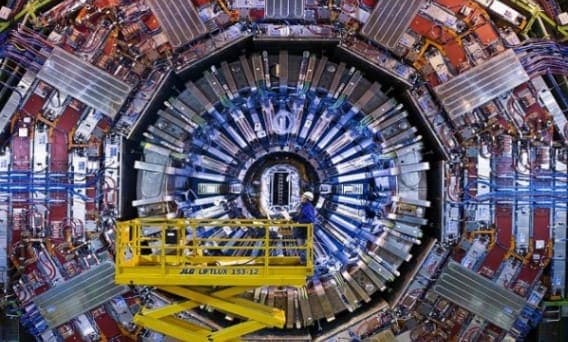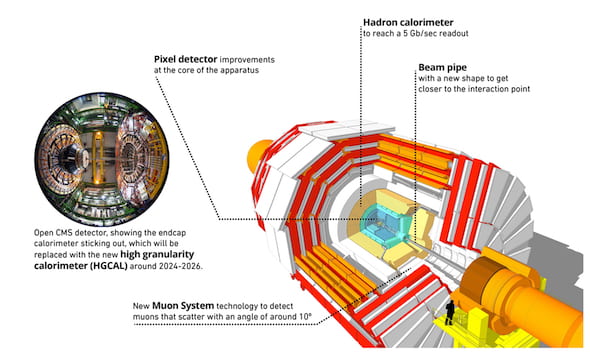
| OP |

The Large Hadron Collider: Unveiling the Mysteries of the Universe
The Large Hadron Collider (LHC), situated at CERN (the European Organization for Nuclear Research) near Geneva, Switzerland, is the world’s most powerful particle accelerator. Spanning an impressive 27 kilometers (17 miles) in circumference and located roughly 100 meters underground, the LHC has allowed scientists to make groundbreaking discoveries, including the confirmation of the Higgs boson. As the LHC continues to explore particle physics, it plays a pivotal role in advancing our understanding of the universe. Here's a virtual tour of the LHC ! CLICK HERE
1. Overview and Purpose of the LHC
The LHC is designed to study the smallest components of matter by accelerating particles to nearly the speed of light and smashing them together in high-energy collisions. These experiments allow scientists to study conditions similar to those of the early universe and explore some of physics' deepest questions, such as:
- What gives particles their mass?
- What are dark matter and dark energy?
- Are there unknown particles and forces in the universe? These pursuits drive physicists to examine the data from collisions and seek answers that push the boundaries of known science. LHC drone footage ! TAP HERE TO WATCH!
2. How the LHC Works
The LHC is a complex, multi-part system that operates on an unprecedented scale. Here’s an outline of its main functions:
- Particle Acceleration: The LHC uses a series of superconducting magnets arranged in a circular path to accelerate protons and other particles to near-light speeds.
- Collisions and Data Collection: Particles are directed to collide at specific points within the LHC, releasing extreme amounts of energy and creating new particles in the process.
- Detection Systems: Detectors surrounding the collision points, including ATLAS, CMS, ALICE, and LHCb, capture data from these collisions to analyze particle behavior, speed, and energy.
Each of the detectors is designed with specific capabilities to study different aspects of particle collisions, allowing scientists to gather a vast amount of data for analysis.
3. The Higgs Boson and the Standard Model of Physics
A significant achievement of the LHC is the discovery of the Higgs boson, a particle predicted by the Standard Model of particle physics. The Higgs boson is associated with the Higgs field, which provides particles with mass as they interact with it. In 2012, the LHC confirmed the existence of the Higgs boson, a discovery that validated a key part of the Standard Model and earned Peter Higgs and François Englert the Nobel Prize in Physics in 2013.
 The Standard Model is a framework that describes the known elementary particles and fundamental forces, except gravity. The discovery of the Higgs boson marked a milestone in modern physics and provided further understanding of how particles acquire mass.
The Standard Model is a framework that describes the known elementary particles and fundamental forces, except gravity. The discovery of the Higgs boson marked a milestone in modern physics and provided further understanding of how particles acquire mass.
4. Structure of the LHC: An Engineering Marvel
![]() The LHC’s design represents a remarkable achievement in engineering, incorporating advanced technology across multiple systems:
The LHC’s design represents a remarkable achievement in engineering, incorporating advanced technology across multiple systems:
- Magnets: The LHC uses over 1,000 superconducting magnets cooled to -271°C, close to absolute zero. These magnets guide and focus the particle beams as they travel through the collider.
- Cryogenics: The LHC’s magnets are kept in a superconducting state through an extensive cryogenic system that maintains the required low temperatures.
- Detectors:
- ATLAS and CMS are general-purpose detectors that discovered the Higgs boson.
- ALICE studies heavy-ion collisions to explore quark-gluon plasma, a state believed to exist shortly after the Big Bang.
- LHCb examines the asymmetry between matter and antimatter, which could explain why the universe is composed mostly of matter.
 These components, working in unison, allow the LHC to produce, capture, and analyze data from some of the most extreme conditions achievable in a laboratory setting.
These components, working in unison, allow the LHC to produce, capture, and analyze data from some of the most extreme conditions achievable in a laboratory setting.
5. Challenges and Innovations
Operating the LHC requires overcoming several technical and logistical challenges:
- Data Processing: The LHC generates vast amounts of data—too much to store fully. Specialized computing systems filter and analyze data in real-time to capture only the most significant events.
- Radiation and Safety: High-energy collisions produce radiation, necessitating robust shielding to protect personnel and equipment.
- Maintenance and Upgrades: Regular shutdowns allow the LHC to undergo upgrades, such as the High-Luminosity LHC (HL-LHC) project, which aims to increase collision frequency for enhanced data collection and rare particle observations.
6. The Future of the LHC and Particle Physics
The LHC is currently undergoing an upgrade to become the High-Luminosity LHC (HL-LHC), which will increase its collision rates and provide more precise data. Beyond the HL-LHC, CERN is considering the construction of an even larger particle accelerator, the Future Circular Collider (FCC), which would be four times the size of the LHC.
These advancements are crucial for exploring physics beyond the Standard Model, including the properties of dark matter, dark energy, and potentially unknown particles or forces.
7. Impact of the LHC on Science and Society
Beyond advancing scientific knowledge, the LHC has had broader impacts on society and technology:
- Scientific Advancements: The LHC’s discoveries deepen our understanding of the universe and have refined theoretical models in particle physics.
- Technological Innovation: The technology developed for the LHC, especially in computing and cryogenics, has broader applications in fields such as medicine and engineering.
- Global Collaboration: The LHC represents a significant international collaboration, with scientists from around the world working together to explore the frontiers of science.
Conclusion
The Large Hadron Collider is one of humanity’s most remarkable scientific achievements, allowing scientists to explore the most fundamental aspects of matter and the universe. From the discovery of the Higgs boson to ongoing studies in particle physics, the LHC continues to shape our understanding of the universe and inspire technological innovations. As the LHC undergoes upgrades and prepares for the future, it remains a crucial tool for answering some of science's most profound questions, pushing the boundaries of what we know and what we have yet to discover.
